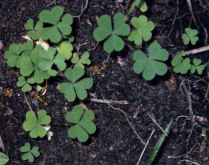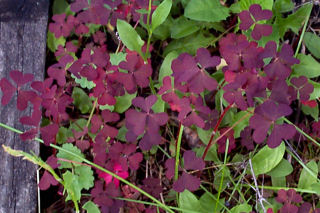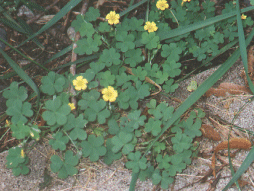|
|
 |
 Yellow wood sorrel is a native North American plant (also found in Eurasia) which may grow either as an annual or as a perennial. This delicate seeming plant forms colonies which arise from slender but tough underground stems (rhizomes). The smooth, palmately compound leaves are divided into three heart-shaped leaflets, each leaflet having a center crease, from which the leaflets fold upward in half. The leaves are most often green, but may also be purplish or brownish red. Wood sorrel folds its leaves up at night and opens them again in the morning. It also folds its leaves when under stress, such as when growing in direct sun, or during storms. The mature plant may reach 6-15" in height. Wood sorrel prefers moist soil, and partial shade, but is also commonly found growing through the cracks in sidewalks. I generally find it growing both through and along sidewalks, alongside trails, in lawns, and in flower beds and gardens. The whole plant has a pleasant sour taste and is virtually odorless. Yellow wood sorrel is a native North American plant (also found in Eurasia) which may grow either as an annual or as a perennial. This delicate seeming plant forms colonies which arise from slender but tough underground stems (rhizomes). The smooth, palmately compound leaves are divided into three heart-shaped leaflets, each leaflet having a center crease, from which the leaflets fold upward in half. The leaves are most often green, but may also be purplish or brownish red. Wood sorrel folds its leaves up at night and opens them again in the morning. It also folds its leaves when under stress, such as when growing in direct sun, or during storms. The mature plant may reach 6-15" in height. Wood sorrel prefers moist soil, and partial shade, but is also commonly found growing through the cracks in sidewalks. I generally find it growing both through and along sidewalks, alongside trails, in lawns, and in flower beds and gardens. The whole plant has a pleasant sour taste and is virtually odorless.

Wood sorrel starts blooming in mid-spring and continues to produce flowers through mid-fall. The yellow flowers are about a half-inch in diameter, with five sepals, five symmetrical petals, and ten stamens. They may occur singly or in clusters of up to five flowers. After a short time, the petals wither, and the ovary develops into an upright, ridged (five ridges, of course) seed pod, half an inch to an inch long, with a short point at the top and the five sepals still at the base. Each seed pod is divided into five compartments, each of which may contain up to about ten seeds. When the pods are dry, they burst open at the slightest touch, scattering seeds over ten feet away. Yellow wood sorrel is distinctive from other wood sorrels in that the seed pods bend sharply upward on their stalks, and the stalks also grow at a sharp angle from the main stalk (both angles are about 90 degrees). It also tends to grow in a more upright fashion than other wood sorrels (stricta means "upright"). Wood sorrels are also called sourgrasses or shamrocks. Though it's often considered to be no more than a troublesome weed, yellow wood sorrel is one of my favorite plants. It is delicate, and yet it can withstand being walked on, mowed to within a quarter inch, and poisoned. It'll grow in sun or shade, good soil or poor. It's easy to recognize, easy to remember, and easy to find, since it grows almost everywhere, and there are no plants that look enough like it to confuse the identification, except for other wood sorrel species.
And when you're hot and thirsty, wood sorrel is wonderfully thirst quenching and refreshing to eat. The leaves, flowers, and immature green seed pods are all edible, with a sour, lemon like flavor. It's a fine thing to find along the trail, which is how I generally eat it, but it can also be added to salads, used in soups (the same way as garden sorrel), used in sauces (traditionally served with fish), or used as a seasoning. A chilled, sweetened, wood sorrel tea makes a refreshing beverage along the lines of lemonade. Wood sorrel is quite high in ascorbic acid (vitamin C) and may provide other nutrients but, as with many of our common plants, the research appears scanty to non-existent. Wood sorrel also contains rather high amounts of potassium oxalate and oxalic acid and should therefore be used in moderation, and avoided by people with kidney disease, kidney stones, rheumatoid arthritis, or gout. Medicinally, in moderate dosages, wood sorrel is cooling (refrigerant, febrifuge), diuretic, stomachic (soothing to the stomach, relieves indigestion), astringent, and catalytic. It's also attributed with blood cleansing properties and is sometimes taken by cancer patients. The whole plant produces an orange to yellow dye. Wood sorrel is another of the primary targets of various broad-leaf herbicides, however herbicides are not very effective on Oxalis species unless used prior to emergence, in which case they'll keep other desirable seeds from sprouting as well. Control is probably best accomplished by hand weeding and mulching where possible. Of course, I encourage wood sorrel in my yard, and have even introduced it in places. A note on the red-leaved wood sorrel:
Selected References
|
|
| Home | About this site | Asides/Glossary | Store |
| Taxonomy Tree | Species list | Article list | |
|
Featured sponsors:
|
Mountain Rose Herbs Bulk herbs, teas, oils, & much more! |
Richter's Herbs Seeds & plants |
|
|
© 1999-2015 by Deb Schwartz. All rights reserved. Please send feedback to: deb@kingdomplantae.net Website by ki-yi.com
|
|||